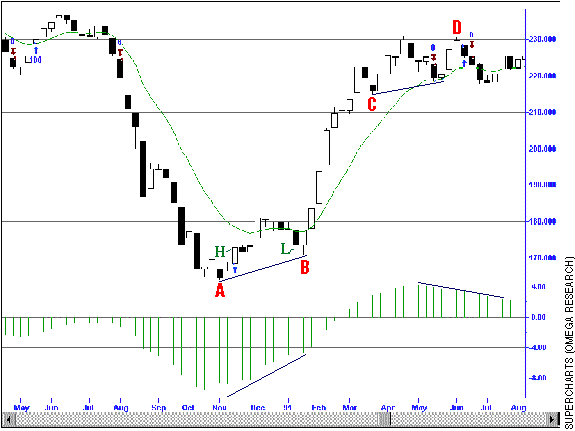The moving average convergence/divergence indicator, developed by Gerald Appel, is constructed by taking the difference of two moving averages of the closing price -- one short, one long. This difference is smoothed with a moving average, and a comparison is made between the difference and its own moving average. For example, first subtract the 26-period moving average from a 12-period moving average to generate the indicator, which can be plotted as a line. A rising MACD line tells us that the momentum of the market is rising, since the "faster," shorter moving average is rising more quickly than the "slower," longer moving average.
Next, obtain a moving average of the MACD line, called a signal line; a popular choice is a nine-period moving average. The traditional interpretation of this indicator is to buy when a rising MACD line crosses above its signal line, and to sell when it crosses below it.
Ultimately, the MACD measures momentum. Its buy signals accompany strong uptrends, while its sell signals are given not when prices actually begin to decline but when the rate of their upward climb slows. This highlights two disadvantages to the indicator: First, its lag means you will miss the early part of any major move, since by the time it's identified the move will be well under way, and second, the sell signals tend to be early, forcing you to exit prematurely.
Here's a modification to this indicator to address these two problems. The idea was inspired by Alexander Elder's Trading for a Living.
THE MACD HISTOGRAM
The MACD histogram is constructed by subtracting the MACD line from the signal line. This can then be plotted as a histogram. In the following examples, I will use a nine-bar/12-bar/nine-bar combination, but traders are welcome to experiment with different parameters.

As an example, examine Figure 1, which shows a weekly candlestick chart of the Value Line Index in 1990-91. At point A, the MACD histogram is negative but rising, hinting that higher prices might lie ahead. Conversely, a high MACD histogram may not necessarily mean higher highs lie ahead if the trend in the MACD histogram is down (for example, after point D). As Elder points out, a market or asset forming higher highs in price not confirmed by higher highs in the Macd histogram may be particularly vulnerable to a correction.